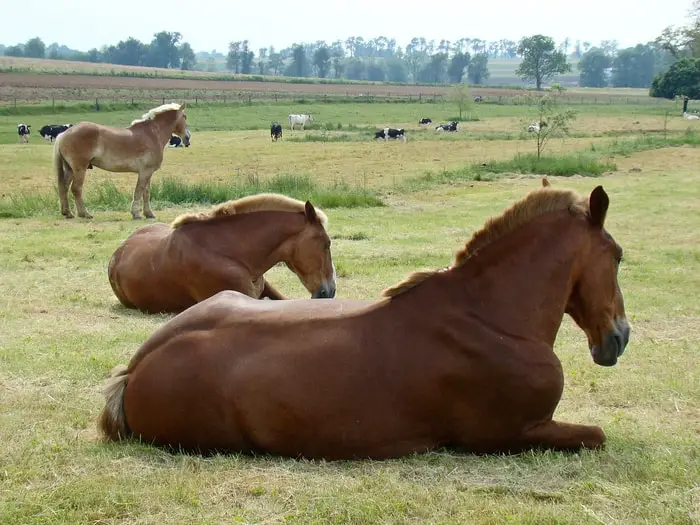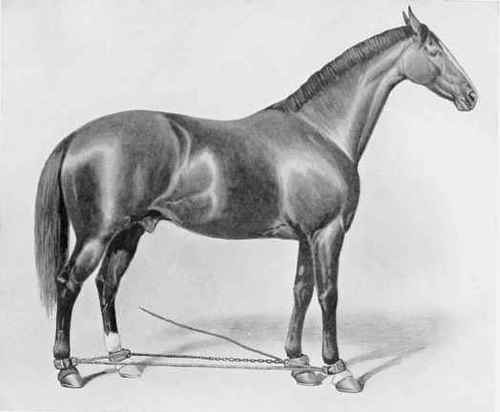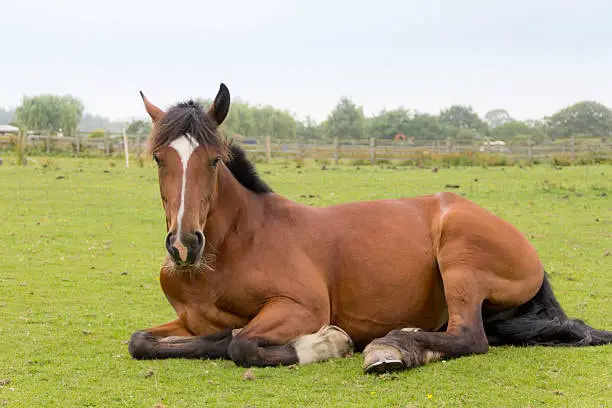Horse Casting is used to describe a horse lying on his side and unable to rise because his legs are too close to the stable wall or fence, or the camber of the ground is such that he can not get his legs underneath his body to get up. Casting usually happens because your horse has either rolled right over or lain down too close to a wall, fence, or bank.
Basics of Horse Casting
Many horses panic and struggle violently, leading to injuries and exhaustion. If the horse remains cast for any length of time, breathing difficulties may occur due to the bulk of the horse’s body compressing the lung on the side in contact with the ground. You must take adequate preparation and precaution while casting a horse. You can take expert advice from my article.

Procedures of Horse Casting: What To Do
- Seek assistance immediately; two large lines and two strong assistants will be needed for your horse. All those assisting should wear hard hats, gloves, and sensible footwear.
- Keep your horse as still and quiet as possible while waiting for help, and any lunge reins are attached by having one person sit or kneel on the neck just behind the cheekbone.
- If your horse is wearing an anti-cast roller, remove it, if necessary, by cutting through the leather or fabric on one or both sides of the metal arch.
- If your horse is close to a corner and the head and neck are bent back, it may be necessary first to slide it backward away from the wall so that he has room to use them to balance and organize himself when rising. Do this by slipping one end of a lunge rein under the neck and through between the front legs, pulling on both ends to slide the horseback.
- If the bed is very well banked up at the sides, removing some of this bedding may give sufficient room for your horse to regain his feet without further assistance. If not, you will have to roll him over; pass one lunge rein around the fore pastern closest to the ground and another around the hind pastern most relative to the ground. Be careful while doing this, particularly not to get trapped between the horse and the wall. Do not tie the lunge reins in place.

- One person should hold both ends of each lunge line, keeping just enough tension to prevent them from slipping off or moving higher up the legs, while the person sitting on the neck gets up and moves to a safe distance.
- Keeping a safe distance from your horse, the people holding the lunge reins should move backward, pulling in a synchronized effort to avoid twisting the spine more than necessary, so your horse rolls over onto his other side. Do not wrap the lunge reins around the hands.
- Once your horse has been rolled over, drop the lunge lines immediately and stand well clear in case the horse leaps to his feet.
- When the horse is up, put a headcollar on him, check for injuries, and call your vet if there is any cause for concern.
- Even if all appears to be well, you should look in on the horse periodically over the next few hours in case further problems arise.
- Once your horse has been freed, he may not always stand immediately but may spend a moment or two propped on his chest resting. If, after a few minutes, he still makes no effort to rise, is unable to do so, or struggles, call your vet.
Horse Control Against a Fence
If your horse has become cast against a fence, it may be easiest and safest to remove the part of the fence he is trapped against. If he goes down in a trailer and becomes stuck, untie his head and pull the breast bar and any partitions that can be moved before attempting to get him on his feet.

Prevention of Accidents During Casting A Horse
It would be best if you tried to follow the code of practice described here as a means of avoiding the problem in the future:
- Bank up beds around the edges to help stop your horse from getting too close to the wall.
- Ensure the stable is big enough for your horse.
- Fit horizontal strips of wood or make grooves along the kicking boards, to give the hooves more purchase rather than sliding across a smooth surface. Your horse will have a chance of being able to push himself away from the wall.
- If your horse is inclined to roll the following exercise, allow him to do so in the school or field before returning him to the stable.
- If your horse tends to roll a lot, check that it is not due to colic, ill-fitting rugs, or itchiness caused by the detergent used to wash his stable clothing.
- Anti-cast rollers can help your horse, but you need meticulous fitting if they are not to cause back injuries. Your horse can still become cast while wearing one.
Final Talk On Casting of Horse
Horse casting is a regular activity on a horse farm. Horse casting enables us to find any injury, minor surgery, medication, health checks, check-ups, and many more events. In my article, I briefly discussed the basics of casting the horse. I think this article will help you a lot.